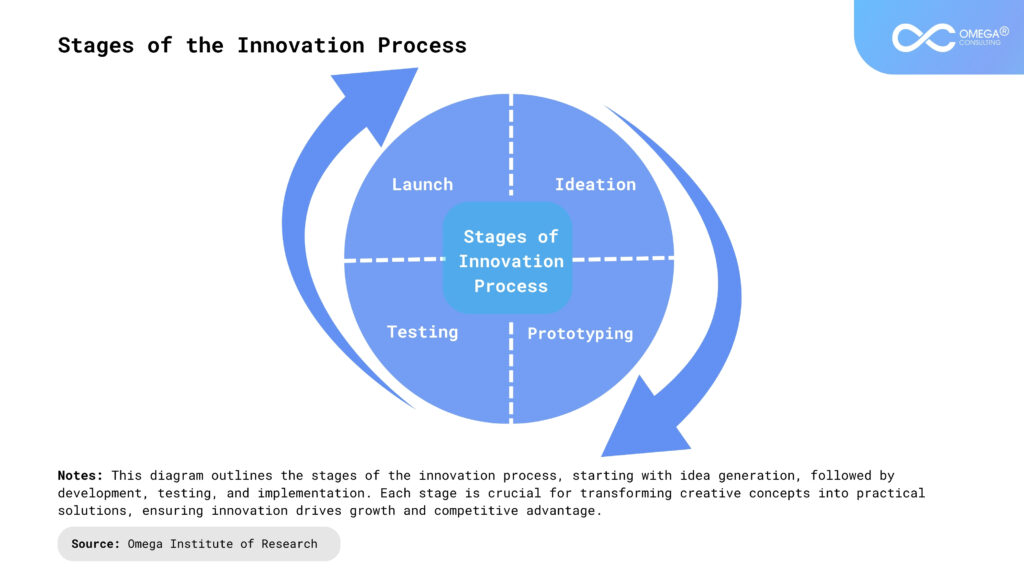- Industries
Industries
- Functions
Functions
- Insights
Insights
- Careers
Careers
- About Us
- Technology
- By Omega Team

Innovation and growth are crucial for companies to maintain a competitive edge in today’s fast-paced business environment. A strategic approach to innovation can enable organizations to create new value propositions, tap into emerging markets, and stay ahead of competitors. Below, we delve deeper into each strategy outlined in the article to provide a comprehensive understanding of how companies can effectively innovate and grow.
Embracing a Culture of Innovation
Creating a culture of innovation is fundamental to fostering creativity and driving new ideas. This culture encourages employees to think outside the box and supports them in turning innovative concepts into reality.
Leadership Support: Leaders play a critical role in setting the tone for innovation. They should demonstrate commitment by investing in innovation initiatives, communicating their importance, and recognizing innovative contributions. When leadership is visibly supportive, employees feel more confident in pursuing creative ideas.
Cross-Functional Teams: Innovation often results from diverse perspectives. By bringing together employees from different departments—such as marketing, engineering, and finance—companies can benefit from a broader range of ideas and insights. Cross-functional teams encourage collaboration and enable faster problem-solving.
Failure Tolerance: Many groundbreaking innovations result from iterative experimentation. Companies that view failure as a step toward success, rather than as a setback, create an environment where employees are more willing to take risks. Establishing a “fail fast, learn faster” approach helps teams pivot quickly based on real-time feedback.

Leveraging Data-Driven Insights
Data-driven decision-making is essential in today’s digital economy. By harnessing the power of data, companies can gain actionable insights into market trends, customer preferences, and operational efficiencies.
Big Data Analytics: Big data refers to large and complex data sets that traditional processing methods cannot handle. Advanced analytics tools can process and analyze this data to uncover patterns and correlations that inform strategic decisions, such as predicting customer behavior or optimizing supply chain management.
Customer Segmentation: Data analytics enables companies to segment their customer base into distinct groups based on characteristics such as demographics, purchasing behavior, and preferences. This segmentation allows for more targeted marketing strategies and personalized customer experiences, which can increase loyalty and drive sales.
Predictive Analytics: Predictive models use historical data and machine learning algorithms to forecast future outcomes, such as demand fluctuations, market trends, or customer churn. By leveraging predictive analytics, companies can proactively address challenges and seize opportunities.

Investing in Research and Development (R&D)
R&D is a cornerstone of innovation, providing the foundation for developing new products, services, and processes that meet evolving market needs.
Strategic R&D Investments: Companies should align their R&D efforts with long-term business goals and market trends. This involves prioritizing projects that have the potential for high impact and return on investment. For example, a tech company might invest in developing AI capabilities, while a pharmaceutical company might focus on innovative drug therapies.
Collaborations: Partnering with academic institutions, research organizations, and other companies can accelerate R&D by combining expertise and resources. Such collaborations can lead to joint development projects, access to specialized knowledge, and reduced time to market.
Innovation Labs: Establishing dedicated innovation labs allows companies to experiment with new technologies, test concepts, and develop prototypes in a controlled environment. These labs act as incubators for ideas that can later be scaled up and commercialized.
Enhancing Customer Experience
In competitive markets, delivering an exceptional customer experience (CX) is a key differentiator. Companies that excel in CX are better positioned to retain customers, build loyalty, and gain positive word-of-mouth referrals.
Personalization: Today’s consumers expect personalized interactions. Companies can use data and AI to create tailored experiences, such as personalized product recommendations, targeted marketing messages, and customized service offerings. Personalization not only enhances customer satisfaction but also increases the likelihood of repeat business.
Omni-Channel Engagement: Customers interact with brands across multiple channels, including websites, social media, and physical stores. An omnichannel approach ensures a seamless and consistent experience across all these touchpoints, enhancing convenience and engagement.
Feedback Mechanisms: Implementing robust feedback systems allows companies to collect, analyze, and act on customer feedback. Whether through surveys, social media monitoring, or direct communication, feedback helps identify areas for improvement and innovation.
Exploring New Markets and Channels
Growth often requires venturing beyond existing markets and exploring new opportunities. This can involve expanding into new geographic regions, targeting different customer segments, or adopting new sales channels.
Market Research: Before entering a new market, companies should conduct comprehensive research to understand local dynamics, regulatory requirements, competitive landscape, and customer preferences. This research helps in crafting strategies that are well-suited to the target market.
Diversification: Diversification involves expanding a company’s product or service portfolio to reduce dependence on a single market or segment. For instance, a software company might develop solutions for different industries, while a food brand could introduce new product lines to appeal to health-conscious consumers.
Digital Channels: The rise of digital commerce has opened new avenues for growth. Companies can leverage e-commerce platforms, social media, and digital marketing to reach new audiences and generate additional revenue streams. This is particularly effective for businesses looking to scale quickly without significant physical infrastructure investments.
Agile Methodologies
Agile methodologies enable companies to respond swiftly to changes in the market and customer needs. These approaches prioritize flexibility, collaboration, and iterative development.
Iterative Development: Agile methodologies, such as Scrum and Lean, emphasize developing products in small, incremental steps. This iterative approach allows teams to release functional versions of a product early and refine them based on user feedback. It reduces the risk of investing heavily in a project only to find it misaligned with market needs.
Scrum and Kanban: Scrum is a framework for managing complex projects through iterative development, while Kanban focuses on visualizing work to improve workflow and efficiency. Both methodologies help teams stay organized, prioritize tasks, and maintain focus on delivering value.
Continuous Improvement: Agile is not a one-time initiative but a mindset of ongoing optimization. Teams regularly review their processes and outcomes, making adjustments to improve efficiency and effectiveness. This culture of continuous improvement ensures that the organization remains adaptive and competitive.
Strategic Partnerships and Alliances
Strategic partnerships can provide access to new markets, technologies, and capabilities, enabling companies to accelerate growth and innovation.
Joint Ventures: Forming a joint venture with another company can be a strategic way to enter new markets or develop new products. For example, two companies might collaborate to combine their technologies and create a new offering that neither could develop independently.
Technology Alliances: Partnering with technology firms can help companies integrate advanced solutions, such as AI, IoT, or blockchain, into their products and services. These alliances can significantly enhance a company’s capabilities and market offerings.
Industry Networks: Participating in industry networks and associations allows companies to stay informed about the latest trends, regulatory changes, and best practices. Networking also facilitates knowledge-sharing and collaboration opportunities.
Fostering a Growth Mindset
A growth mindset encourages employees to view challenges as opportunities for development and to believe that their abilities can be enhanced through effort and learning.
Continuous Learning: Companies should promote a culture of learning, offering employees opportunities for professional development through training programs, workshops, and access to educational resources. A well-informed workforce is better equipped to innovate and solve complex problems.
Adaptability: Organizations must be willing to adapt their strategies and operations in response to market changes or disruptions. This might involve shifting focus to new business areas, embracing digital transformation, or reorganizing teams to better align with strategic goals.
Goal Setting: Setting clear, measurable goals helps align the organization’s efforts and provides a roadmap for growth. These goals should be challenging yet achievable, fostering motivation and accountability. Regularly reviewing and adjusting goals ensures they remain relevant and aligned with the company’s strategic direction.

Case Studies in Innovation and Growth
Apple – Reinventing the Smartphone Market
Challenge: Apple faced intense competition from rivals like Samsung and Nokia, who dominated the smartphone market with traditional feature phones.
Solution: Apple introduced the iPhone, a revolutionary touchscreen smartphone that challenged the status quo. The iPhone featured a sleek design, intuitive interface, and innovative app store, offering a superior user experience.
Outcome: The iPhone became a massive success, transforming the smartphone market and solidifying Apple’s position as a technology leader. Apple’s innovative approach and focus on user experience drove significant growth and profitability.
Netflix – Disrupting the Entertainment Industry
Challenge: The traditional video rental business model was facing challenges from digital streaming services like YouTube. Netflix needed to adapt to changing consumer preferences.
Solution: Netflix transitioned from a DVD rental service to a streaming platform, offering a vast library of movies and TV shows on demand. Netflix also invested in original content production, creating exclusive shows that attracted a loyal subscriber base.
Outcome: Netflix’s innovative approach disrupted the entertainment industry, becoming a global leader in streaming services. The company’s growth was fuelled by its ability to anticipate consumer trends and deliver a superior streaming experience.
Tesla – Pioneering Electric Vehicles
Challenge: The automotive industry was dominated by traditional gasoline-powered vehicles, with limited adoption of electric vehicles. Tesla faced skepticism and challenges in introducing a new technology.
Solution: Tesla developed and manufactured a range of electric vehicles, including the Model S, Model X, and Model 3. The company focused on performance, range, and innovative features, challenging the perception of electric cars as inferior to gasoline-powered vehicles.
Outcome: Tesla’s innovative approach and high-quality electric vehicles have accelerated the adoption of electric vehicles. The company has become a leader in the electric vehicle market, driving significant growth and challenging traditional automotive manufacturers.

Future Trends of Innovation and Growth Strategies
As technology continues to evolve and global markets become increasingly interconnected, the landscape of innovation and growth strategies is rapidly changing. Here are some key trends to watch:
AI-Driven Innovation: AI will enable companies to tailor products and services to individual customers with unprecedented precision. AI-powered autonomous systems will revolutionize industries such as transportation, manufacturing, and healthcare. The AI algorithms will help businesses anticipate future trends, identify risks, and optimize operations.
Sustainability and Circular Economy: Consumers and investors are increasingly demanding sustainable products and services. Companies will focus on reducing waste, reusing materials, and extending product life cycles. Investments in renewable energy sources will continue to grow, driving innovation in clean technologies.
Digital Transformation: Cloud-based solutions will enable businesses to scale operations, reduce costs, and enhance flexibility. Connected devices will generate vast amounts of data, providing valuable insights for decision-making. As digital threats become more sophisticated, cybersecurity will be a top priority for businesses.
Biotechnology and Healthcare: Advancements in biotechnology will enable personalized treatments based on individual genetic makeup. Technologies like CRISPR will revolutionize healthcare and agriculture by modifying DNA. Research into aging and longevity will drive innovation in healthcare and wellness products.
Experiential Marketing: Companies will focus on creating memorable and engaging experiences for customers. Social media platforms will become increasingly important for e-commerce and customer engagement.AR and VR technologies will enhance customer experiences and create new business opportunities.
Conclusion
Helping companies innovate and grow in competitive markets requires a holistic approach that combines cultural, strategic, and operational initiatives. By fostering a culture of innovation, leveraging data, investing in R&D, enhancing customer experience, exploring new markets, adopting agile methodologies, forming strategic partnerships, and cultivating a growth mindset, companies can position themselves to succeed in the face of competition and change. The key is to remain proactive, flexible, and committed to continuous improvement, ensuring that the organization can navigate challenges and seize opportunities as they arise.
- https://www.weforum.org/
- https://www.wavetec.com/blog/business-strategy-innovation/
- https://thunderbird.asu.edu/thought-leadership/insights/benefits-innovation-growth-strategy-and-how-create-one-your
Subscribe
Select topics and stay current with our latest insights
- Functions